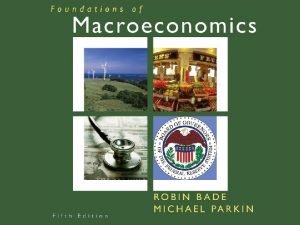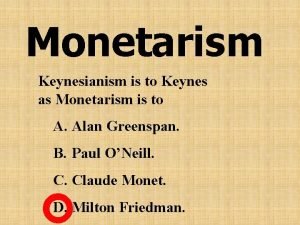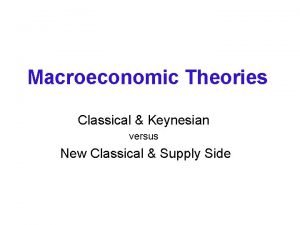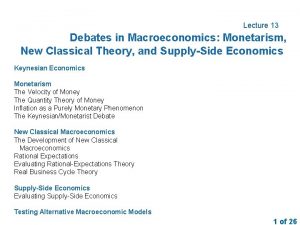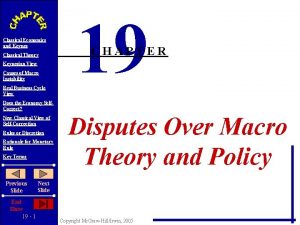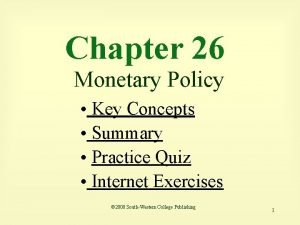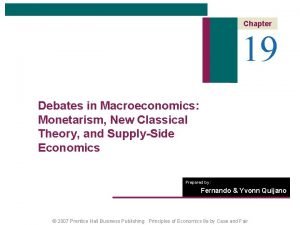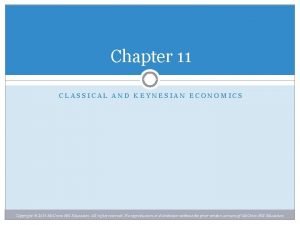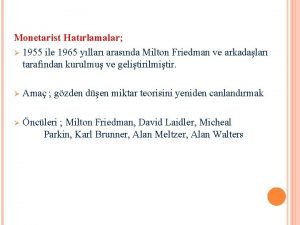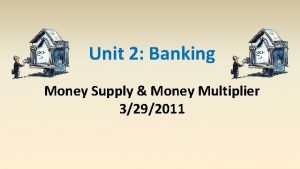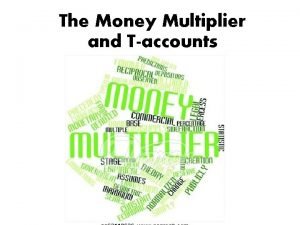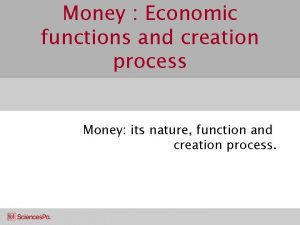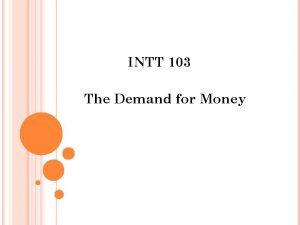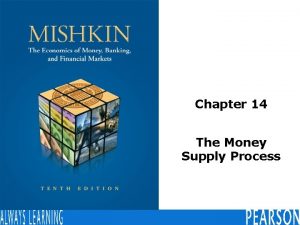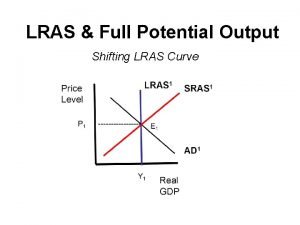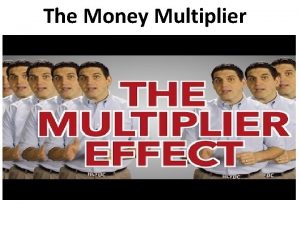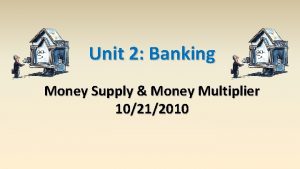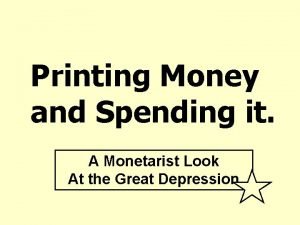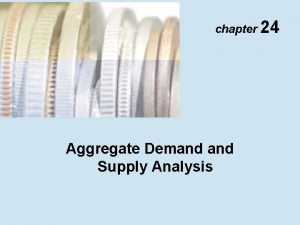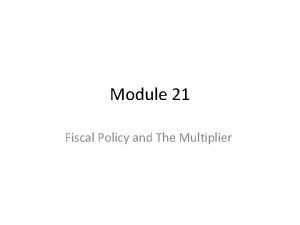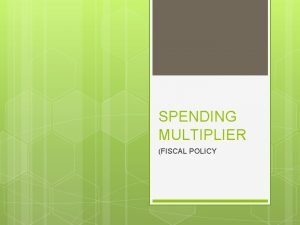MONETARIST LRAS Money Supply Multiplier Accelerator 5 most
















![Exam Questions 7 (a) For what purposes do people demand money? [10] Liquidity Preference Exam Questions 7 (a) For what purposes do people demand money? [10] Liquidity Preference](https://slidetodoc.com/presentation_image/1f8fecdcfe357bf346345b3cc3dbca98/image-17.jpg)
- Slides: 17

MONETARIST LRAS Money Supply Multiplier/ Accelerator 5 most important points Aggregat e Demand 45˚ line

Keynesian Theory - Total Expenditure (or AMD) and the way in which the level an equilibrium level of income is achieved. Total Expenditure is made up of: C+I+G+(X-M) 1. The Propensity to Consume Any determinant of C other than income changes Marginal Propensity to Consume WHOLE C will shift. Consumption M N The relationship between a small change in Y and the corresponding change in C = (∆C/∆Y) is known as: Marginal Propensity to Consume C L Income MPC = LM/LN

2. Consumption, Savings and Equilibrium Income C = a+c(Yd) a= autonomous c= MPC Consumption C MPC is Constant APC falls as Y rises APC>MPC Income C APC=MPC constant at all levels of Y Income

Equilibrium Income - Two. Common Sector Errors: 1. C and S are NOT parallel Economy 2. The income level at which Y=C is Y=Exp Expenditure AMD (C + I) P =S C Q Y=C S + A D Dis. Saving I =S 0 45˚ X 1 Dis-Saving _ NOT the equilibrium level of Y which occurs where AMD crosses the 45˚ line. To Remember: 1. OA is autonomous consumption. 2. Any consumption up to C=Y must be financed. 3. At OX 1 all income is spent 4. At OB consumption = BQ and saving= PQ 5. Equilibrium level of Y shown in 2 ways a) where AMD crosses 45˚ line b) Planned S = Planned I - point D Yeq B S=0 Income Remember the following equilibriums: 2 sector - S=I With Govt - S+T = I+G With Govt and Trade - S+T+M = I+G+X

Spending on goods and services other than consumption - i. e. it involves the creation of new physical assets. Marginal Efficiency of Capital - MEC As investment increases, the return on the last unit of capital employed will be less and less as a result of the law of diminishing returns. Profitable to invest as long as the MEC - % return - is greater than the rate of interest. Optimum - %MEC = the rate of The marginal return on % MEC and investment of 0 A is thus Rate of interest Interest 10%; if investment is 10% MEC 8% 0 Investment A B increased to 0 B, the marginal return falls to 8%

3. Investment - cont’d Accelerator - relationship between net investment and the rate of change of national output. Assumes a constant capital to output ratio e. g. $3 m of capital has to be purchased to increase output by $1 m accelerator co-efficient is said to be 3. Year Demand Machines at start of year Machines required Replacement Investment Induced Investment Total Investment 1 800 8 8 1 0 1 3 1000 8 10 1 2 3 3 1600 10 16 1 6 7 4 1800 16 18 1 2 3 5 1800 18 18 1 0 1 6 1700 18 17 0 0 0 Limitations of Accelerator: * Firms can meet output with stocks - may not need investment * Changes in technology may mean firms don’t need to invest in as much capital as before * Firms need to be convinced that demand is long-term to warrant investment * Limited supply of technology available

4. Circular Flow & Multiplier Most circular flow questions refer to the idea of Equilibrium Income. This occurs where injections = withdrawals: I+G+X = S+T+M Injections Withdrawals Calculations for MC. Example - C=10 + a. Y I=5 G=25 X=12 M=16 a=0. 6 therefore Y = 10 +. 6 Y + 5 + 25 + (12 -16). 4 Y = 40 - 4 Y = 90 Multiplier - the number of times an initial change in expenditure (i. e. C or I or G) must be multiplied in order to arrive at the consequent change in income. Equations: 1 or ___1___ value (1 - MPC) MPS + MPT + MPM The higher the value of the MPC the greater the of the multiplier. Example - Government increases its spending by $50 m, Investment increases by $80 m and exports increases by $70 m. Out of any increase in income 3/4 is consumed, and the remainder saved, taxed or spent on imports. Final increase in Y = ($50 m+$80 m+$70 m) x 1 =$200 m x 4 = $800 m

Diagrammatic Representation of Multiplier = EXP C+I+G 2 S C+I+G 1 T 45˚ Y Y 1 Y ∆Y ∆J YY 1 ST

Deflationary Gap Inflationary Gap EXP AMD 2 a AMD 1 a AMD 2 AMD 1 b b 45˚ Y Actual FE Y The deflationary gap is ab = the amount by which AMD must rise to increase Y to its Full Employment (FE) level. FE Y Actual Y The inflationary gap is ab = the amount by which AMD must be reduced to remove demand-pull inflation i. e. to make nominal Y at FE = real Y at FE

Questions often ask by how much must J (injections) be increased to eliminate a deflationary gap. “The full employment level of Y is $250 m; the present level of Y is $200 m. Four-fifths of any increase in Y is spent. By how much must investment (I) be increased to eliminate the gap? Necessary final increase in Y = $250 m - $200 m = $50 m K= 1 (1 - 0. 8) = 1 = 5 therefore ∆ I = $50 m = $10 m 0. 2 Demand for Money - Liquidity Preference Interest Rate T P Liquidity Trap S Money

Monetarist Theory Monetarism is an economic school of thought that stresses the primary importance of the money supply in determining nominal GDP and the price level. Characteristics - Monetarism is a mixture of theoretical ideas, philosophical beliefs, and policy prescriptions. Here we list the most important ideas and policy implications and explain them below. 1. The theoretical foundation is the Quantity Theory of Money. 2. The economy is inherently stable. Markets work well when left to themselves. Government intervention can often times destabilize things more than they help. Laissez faire is often the best advice. 3. The Central Bank should be bound to fixed rules in conducting monetary policy. They should not have discretion in conducting policy because they could make the economy worse off. 4. Fiscal Policy is often bad policy. A small role for government is good.

Quantity Theory of Money Mx. V=Px. T M= stock of money V = velocity of circulation P = Average Price Level transactions Calculation: if M=$60, V=4 and T=12, then P can be found. T = Volume of P = MV = 60 x 4 = $20 T 12 Macro-questions should normally be tackled from a Keynesian standpoint unless otherwise advised. Principal monetarist propositions: 1. Money is a unique asset, and it can be distinguished from all other financial and real assets. 2. Increases in the money supply (after a time lag) produce a proportionate increase in nominal income, at first in output, and later in the general level of prices. 3. Monetary policy is an effective technique for controlling the economy; fiscal policy is ineffective and incomes policy is counter-productive. 4. Effective monetary policy requires the adoption of a system of monetary base control, as well as a ‘monetary rule’ (where the annual rate of allowable monetary growth is equal to the expected rise in real output) with a view of influencing expectations in a downward direction. 5. Reduction of Government borrowing reduces monetary growth and thus also inflation. 6. Increases in Government spending simply increase inflation and not employment. 7. Unemployment can only be maintained at a level below its natural rate at the cost of accelerating inflation. 8. Excessive wage increases in tight monetary conditions increase unemployment.

Keynesian Monetarist The economy is basically unstable. Markets do not function efficiently. Private expenditure is very volatile. Depressions and mass unemployment can persist - no automatic tendency to self-correction in the economy. The economy is basically stable. Price changes efficiently allocate resources. Private expenditure is relatively stable. Full employment (or 'the natural rate of unemployment') is the normal condition - deviations are temporary. Inflation is caused by independent cost -push factors (wages and output Inflation is caused by excessive growth prices) and causes increases in the of the money supply. Governments use of fiscal policy is Governments use fiscal policy to doomed to failure. Reflation simply manipulate the economy. Budget means inflation. No long-run trade off deficits act as stimulus to the economy between inflation and unemployment. via the multiplier. Monetary policy can Budget deficits cause increase in only be used to influence interest rates. money supply and/or increases in 'Money' is impossible to define and interest rates, crowding out private attempts to control the money stock at expenditure. Reduction in inflation is a best irrelevant and at worst cause precondition of success in other permanent loss of output. objectives. Demand for money is interest-elastic Demand for money is interest-inelastic

Price Level Extreme Monetarist Extreme Keynesian Price Level AS AS P 1 AMD 2 P P AMD 1 AMD Output (real income) AMD 1 Output (real income)

(b) Explain what is meant by liquidity preference and discuss how it might be affected by an increase in unemployment. [13] June 2010 Demand for money/liquidity preference based on transactions plus precautionary demand – the demand for active balances. Speculative demand - interest elastic - depends on expectations of future changes in bond prices. Price of Bonds and Rate of Interest inversely related. It is determined by income; frequency with which people are paid; time of year; method of payment – use of credit cards reduces active balance demand; some influence on precautionary demand from the rate of interest – although this is likely to be more relevant to firms’ active balances than individuals. An increase in unemployment would affect income: Less consumption but compensating change in the use of credit cards. People move more money out of precautionary into transactionary. The demand for precautionary tends to rise with income. Company profits/returns most likely reduced and liquidity preference change. More into transactionary.

Exam Questions 7 (a) Explain the factors influencing the level of investment in an economy. [10] MEC theory - Business confidence - change in technology, lower taxes expected profits, stock levels (b) Discuss the extent to which national income is determined by private investment. [15] Nov 2008 Explanation of the multiplier process - graph to explain Private investment - job creation - consumption - AD etc Also - political stability, natural resources, size of labour force, unrest and war.
![Exam Questions 7 a For what purposes do people demand money 10 Liquidity Preference Exam Questions 7 (a) For what purposes do people demand money? [10] Liquidity Preference](https://slidetodoc.com/presentation_image/1f8fecdcfe357bf346345b3cc3dbca98/image-17.jpg)
Exam Questions 7 (a) For what purposes do people demand money? [10] Liquidity Preference - explained. Active /Idle balances. Graphs (b) Discuss the effect of an increase in the supply of money on interest rates and national income (15). June 2008 Money supply↑interest rates ↓ Investment and borrowing ↑, Investment ↑ + multiplier affect = national income ↑. Liquidity Trap - Japan 1990’s. Today Central Banks rates extremely low. Graphs to explain this - definition of multiplier and examples
 Monetarist lras
Monetarist lras Dana damian
Dana damian Monetarist vs keynesian vs classical
Monetarist vs keynesian vs classical Keynesian vs classical vs monetarist
Keynesian vs classical vs monetarist Keynesian vs classical vs monetarist
Keynesian vs classical vs monetarist Monetarist vs classical economics
Monetarist vs classical economics Monetarist vs classical economics
Monetarist vs classical economics Monetarist vs classical economics
Monetarist vs classical economics New classical macroeconomics
New classical macroeconomics Keynesian vs classical vs monetarist
Keynesian vs classical vs monetarist Classical theory vs keynesian theory
Classical theory vs keynesian theory Rasyonel bekleyişler teorisi nedir
Rasyonel bekleyişler teorisi nedir Money multiplier
Money multiplier Money multiplier economics
Money multiplier economics Simple money multiplier
Simple money multiplier What is money multiplier formula
What is money multiplier formula The three players in the money supply process
The three players in the money supply process Formula of money multiplier
Formula of money multiplier


